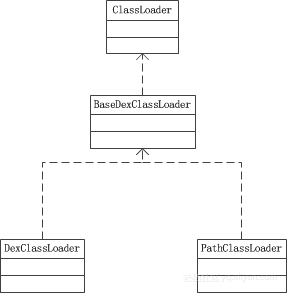传统的app开发模式下,线上出现bug,必须通过发布新版本,用户手动更新后才能修复线上bug。随着app的业务越来越复杂,代码量爆发式增长,出现bug的机率也随之上升。如果单纯靠发版修复线上bug,其较长的新版覆盖期无疑会对业务造成巨大的伤害,更不要说大型app开发通常涉及多个团队协作,发版排期必须多方协调。
那么是否存在一种方案可以在不发版的前提下修复线上bug?有!而且不只一种,业界各家大厂都针对这一问题拿出了自家的解决方案,较为著名的有腾讯的Tinker和阿里的Andfix以及QQ空间补丁。网上对上述方案有很多介绍性文章,不过大多不全面,中间略过很多细节。笔者在学习的过程中也遇到很多麻烦。所以笔者将通过接下来几篇博客对上述两种方案进行介绍,力求不放过每一个细节。首先来看下QQ空间补丁方案。
1. Dex分包机制
大家都知道,我们开发的代码在被编译成class文件后会被打包成一个dex文件。但是dex文件有一个限制,由于方法id是一个short类型,所以导致了一个dex文件最多只能存放65536个方法。随着现今App的开发日益复杂,导致方法数早已超过了这个上限。为了解决这个问题,Google提出了multidex方案,即一个apk文件可以包含多个dex文件。
不过值得注意的是,除了第一个dex文件以外,其他的dex文件都是以资源的形式被加载的,换句话说就是在Application.onCreate()方法中被注入到系统的ClassLoader中的。这也就为热修复提供了一种可能:将修复后的代码达成补丁包,然后发送到客户端,客户端在启动的时候到指定路径下加载对应dex文件即可。
根据Android虚拟机的类加载机制,同一个类只会被加载一次,所以要让修复后的类替换原有的类就必须让补丁包的类被优先加载。接下来看下Android虚拟机的类加载机制。
2. 类加载机制
Android的类加载机制和jvm加载机制类似,都是通过ClassLoader来完成,只是具体的类不同而已:
 1
1
Android系统通过
PathClassLoader来加载系统类和主dex中的类。而DexClassLoader则用于加载其他dex文件中的类。上述两个类都是继承自BaseDexClassLoader,具体的加载方法是findClass:
public class BaseDexClassLoader extends ClassLoader {
private final DexPathList pathList;
/**
* Constructs an instance.
*
* @param dexPath the list of jar/apk files containing classes and
* resources, delimited by {@code File.pathSeparator}, which
* defaults to {@code ":"} on Android
* @param optimizedDirectory directory where optimized dex files
* should be written; may be {@code null}
* @param libraryPath the list of directories containing native
* libraries, delimited by {@code File.pathSeparator}; may be
* {@code null}
* @param parent the parent class loader
*/
public BaseDexClassLoader(String dexPath, File optimizedDirectory,
String libraryPath, ClassLoader parent) {
super(parent);
this.pathList = new DexPathList(this, dexPath, libraryPath, optimizedDirectory);
}
@Override
protected Class<?> findClass(String name) throws ClassNotFoundException {
List<Throwable> suppressedExceptions = new ArrayList<Throwable>();
Class c = pathList.findClass(name, suppressedExceptions);
if (c == null) {
ClassNotFoundException cnfe = new ClassNotFoundException("Didn't find class \"" + name + "\" on path: " + pathList);
for (Throwable t : suppressedExceptions) {
cnfe.addSuppressed(t);
}
throw cnfe;
}
return c;
}
}
从代码中可以看到加载类的工作转移到了pathList中,pathList是一个DexPathList类型,从变量名和类型名就可以看出这是一个维护Dex的容器:
/*package*/ final class DexPathList {
private static final String DEX_SUFFIX = ".dex";
private static final String JAR_SUFFIX = ".jar";
private static final String ZIP_SUFFIX = ".zip";
private static final String APK_SUFFIX = ".apk";
/** class definition context */
private final ClassLoader definingContext;
/**
* List of dex/resource (class path) elements.
* Should be called pathElements, but the Facebook app uses reflection
* to modify 'dexElements' (http://b/7726934).
*/
private final Element[] dexElements;
/**
* Finds the named class in one of the dex files pointed at by
* this instance. This will find the one in the earliest listed
* path element. If the class is found but has not yet been
* defined, then this method will define it in the defining
* context that this instance was constructed with.
*
* @param name of class to find
* @param suppressed exceptions encountered whilst finding the class
* @return the named class or {@code null} if the class is not
* found in any of the dex files
*/
public Class findClass(String name, List<Throwable> suppressed) {
for (Element element : dexElements) {
DexFile dex = element.dexFile;
if (dex != null) {
Class clazz = dex.loadClassBinaryName(name, definingContext, suppressed);
if (clazz != null) {
return clazz;
}
}
}
if (dexElementsSuppressedExceptions != null) {
suppressed.addAll(Arrays.asList(dexElementsSuppressedExceptions));
}
return null;
}
}
DexPathList的findClass也很简单,dexElements是维护dex文件的数组,每一个item对应一个dex文件。DexPathList遍历dexElements,从每一个dex文件中查找目标类,在找到后即返回并停止遍历。所以要想达到热修复的目的就必须让补丁dex在dexElements中的位置先于原有dex:
 2
2
 3
3
这就是QQ空间补丁方案的基本思路,接下来的博文笔者将以一个实际的例子详述QQ空间补丁热修复的过程













网友评论